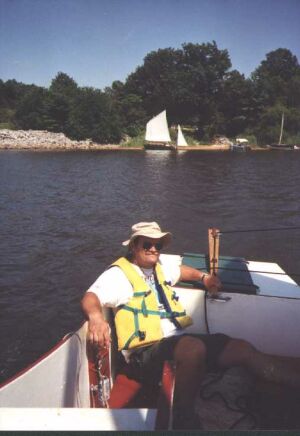
Richard Spelling in the original AF2 at Rend Lake a few years ago.
Contents:
Contact info:
Jim Michalak
118 E Randall,
Lebanon, IL 62254Send $1 for info on 20 boats.
Jim Michalak's Boat Designs
118 E Randall, Lebanon, IL 62254
A page of boat designs and essays.
(1mar06) This issue will figure a sail rig for new Raider design. The 15 March issue will put some structure into the Raider.
THE BOOK IS OUT!
BOATBUILDING FOR BEGINNERS (AND BEYOND)
is out now, written by me and edited by Garth Battista of Breakaway Books. You might find it at your bookstore. If not check it out at the....ON LINE CATALOG OF MY PLANS...
...which can now be found at Duckworks Magazine. You order with a shopping cart set up and pay with credit cards or by Paypal. Then Duckworks sends me an email about the order and then I send the plans right from me to you.
MESSABOUT NOTICE:
THE REND LAKE MESSABOUT WILL TAKE PLACE ON JUNE 9, 10 AND 11 AT THE GUN CREEK RECREATION AREA AT REND LAKE IN SOUTHERN ILLINOIS. MORE DETAILS WILL FOLLOW BUT IT MIGHT BE PRUDENT TO MAKE CAMPING RESERVATIONS IF YOU INTEND TO ATTEND.

|
Left:
Richard Spelling in the original AF2 at Rend Lake a few years ago.
|
|
|
Raider Design 2
BACK TO THE RAIDER....
To review, here is a preliminary sketch of the Raider, intended to row/sail a crew of up to four, but no need to carry supplies:
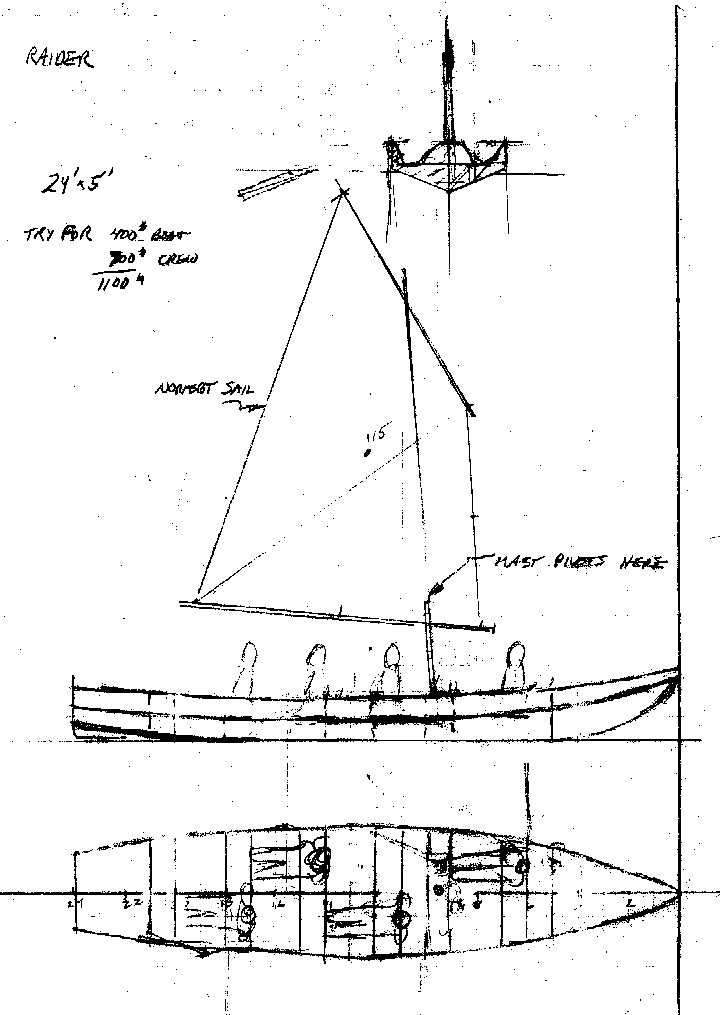
I drew up the lines, measured the offsets and made this Hullforms model with those offsets:
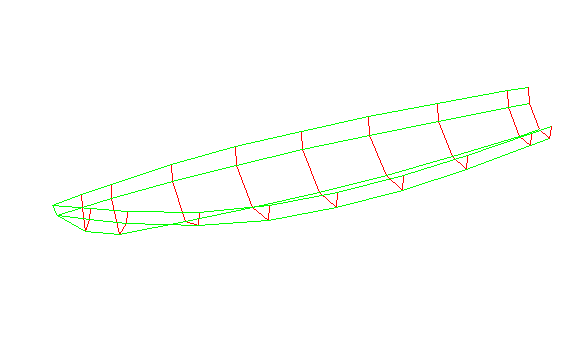
NOW ON TO THAT SAIL RIG...
...THIS IS NOT GOING TO BE ROUTINE. We have to allow room for four rowers and the sail rig needs to fit the rowers, not the case of the rowers fitting around the sail rig. Here is what the rowing situation looks like:
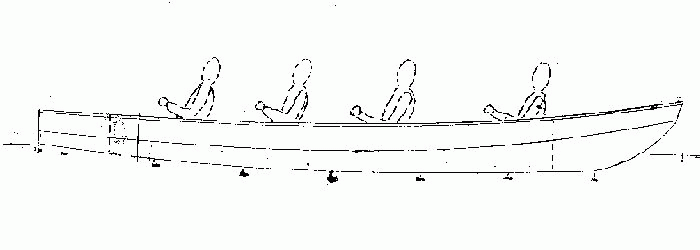
The race is such that there are times when rowing is the only way, and times when sailing is the only way, and the in between times when one might swap quickly between rowing and sailing, and finally there should be allowance to row with the sail rig up and drawing. And...
...the fellow who wants the boat has a Normsboat and is fully hooked on the balanced lug rig with pivoting leeboards. So what might be a traditional sail rig with stays is out. Well, I'm all for the rig he wants and it is my bread and butter, so to speak.
NOW...
... as you know from my essays, a leeboard system must be at the boat's widest beam for it to be placed in flow parallel to the boat's motion. And the lug rig with no stays must be installed on some solid structure. Well, this was supposed to be an open rowing boat but a solid bulkhead is needed to take the rig. I decided it could only go in between rowers 1 and 2. I don't think it can go anywhere else. The bow oarsman will be separated from the rest. He will have to climb around the rig and over the bulkhead to join the stern party. Such is life.
But I think there is another big problem here. The leeboard must also be attached to something solid and, again, this was supposed to be an open light boat. Furthermore, although I haven't done any study on the forces on the sail rig it is somewhat clear that the forces could be quite large given four adults all hiked out to one side on a breezy day. So I intend to hang the leeboard on a second bulkhead a short ways aft of the first with the top area between the two bulkheads plated over to form a sturdy box in that area. (The bulkheads could have significant access holes in them to allow for storage in that structural box.) So in a way we aren't going to hang the sail rig on the boat, we are going to hang the boat on a solid base of a sail rig.
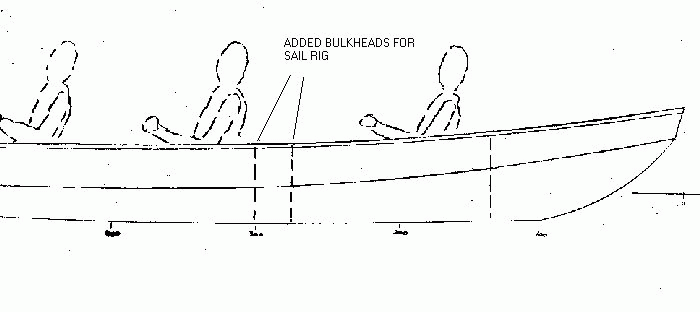
BUT.....
... that bulkhead is not at the boat's widest beam. We have to compromise here. To put the sail rig at the ideal point would totally disrupt the rowing configuration. So the leeboard will be forward of the widest beam and maybe not it flow parallel to the boat's motion since the hull is still pushing the water apart at that point. But not by much since this is a long narrow hull. And maybe not at all since on this V hull the leeboard's area will normally be well below the hull's side.
ANOTHER COMPLICATION...
...results from the narrow low sides of Raider. The owner already has the Normsboat 115 sq ft sail and likes it. Might as well put it in the design. Now, you may recall there is a relationship between the size of the sail and the size of the underwater lateral board area and as a general rule the board in the water should be about 4% of the sail area. If it is less the boat can have high leeway and drag when close hauled in rough going and high winds. 4% of 115 sq ft is 4.6 sq ft. (I've temporarily lost my ability to think metric!) Let's see, 115 sq ft is 10.6 sq meters and 4.6 sq ft is .42 sq meters. Now, on this low narrow boat the leeboard must be no more than 30cm wide in order to tuck up under the wale while rowing. So to get the desired area the "board in the water" must be 140 cm long. So it must be very long and narrow, like this:
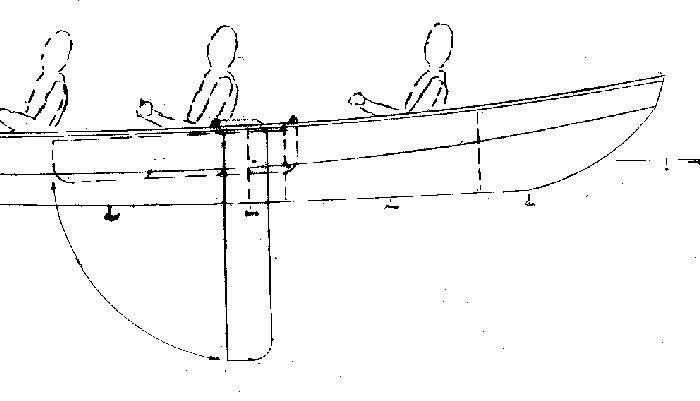
If the long deep leeboard bothers one he might try two shorter boards, one on each side. I would try the one shown first and change it if not satisfactory.
AMOST FORGOT...
...the sail rig was supposed to be mounted in such a way that it can be put up and down in an instant and when stowed has to be out of anyone's way as far as rowing is concerned. So we have a tabernacle that is quite tall like this;
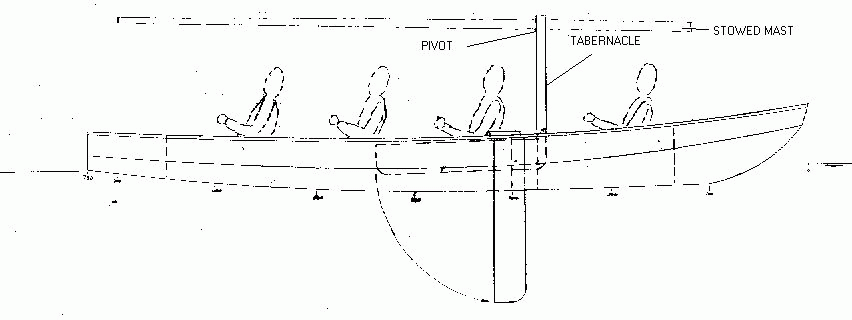
Watch your head!
FINALLY let's add the Normsboat sail. (Remeber that the yard on the lug rig should cross the mast about 40% aft from the luff in order for the balanced lug to balance properly.)
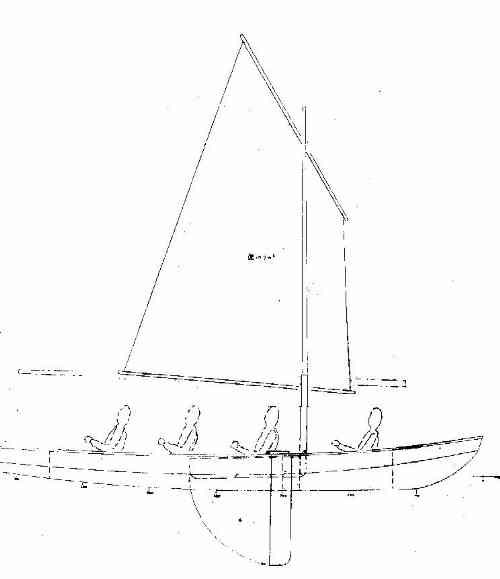
It looks to be a bit aft of the leeboard area. But I would try it as is because a) on a long boat like this the rudder will be quite powerful and can be used to carry the extra weather helm stirred up by the aft sail. And b) the leeboard can easily be swept aft to trim the weather helm. And c) it will be easy to sweep the mast forward to move the sail area forward.
IN SUMMARY, I think it will work as shown. But to recap, because of the need to preserve the rowing stations we have designed the sail rig backwards, from hull structure to leeboard to sail. Normally we would start with the sail, then on to the leeboard and finally on to the structure.
NEXT TIME...
...we take another step in drawing this boat.
Shanteuse
SHANTEUSE, SHANTYBOAT, 16' X 6', 700 POUNDS EMPTY

Shanteuse is a slight enlargment of the mini shanty Harmonica. Shanteuse is 1' wider than Harmonica and has a 3' extension on the stern to allow a small back porch and a motor mount that is totally out of the living area.

Above is a Shanteuse built in Florida by Vince SantaMaria a couple of years back but he stretched his to 24' so I couldn't really call that one a Shanteuse. But here is one by Douglas Snelson in Tennessee that looks to be right to the plans so I will call this one the prototype. He sent a bunch of photos:
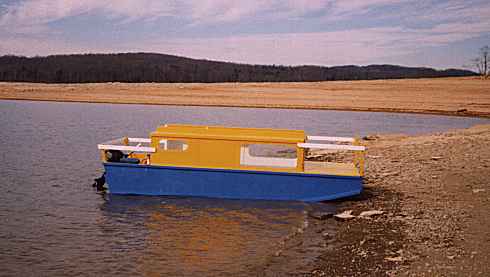
I've also made Shanteuse a little heftier. I'm thinking this one will weigh about 700 pounds empty where Harmonica comes in at around 400 pounds. I'm not sure if the extra beef is needed because Harmonica seemed totally adequate to me as far as strenght and stiffness go. But the extra size of Shanteuse is probably going to take it out of the compact car tow class. The plywood bill for Shanteuse looks like six sheets of 1/2" plywood and eight sheets of 1/4" plywood. I would not use fancy materials on a boat like this and am reminded of Phil Bolger's warning to never spend a lot of money building a design that was intended to look cheap. I see pine exterior plywood at my local lumberyard selling for $11 or a 3/8" sheet and this entire boat could be built of it. So the plywood bill would be less than $200 and I'm thinking the entire bill less than $500. The pine plywood looks quite good to me, its main drawback being that it doesn't lay very flat.
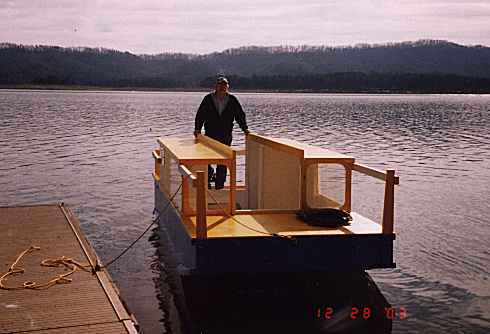
These boats can be very comfortable to camp in. The interior volume and shape are not unlike the typical pickup camper or the volume in a full sized van. It's not huge, it's cozy. The top has an open slot 28" wide from front to back on centerline. You can close it over with a simple tarp, leave it open in good weather, or rig up a full headroom tarp that covers the entire boat. I've shown lots of windows but the window treatment can be anything you like. You do need to see out. I would be tempted to cover the openings with screen and use clear vynal covers in the rain or cold. For hard windows I think the best material might be the Lucite storm window replacements sold at the lumberyard. Easily worked, strong, and not expensive.
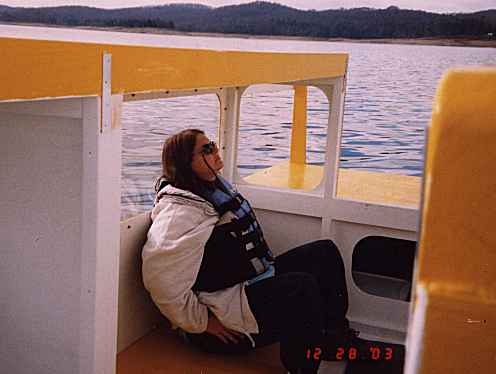
As for operation, these are smooth water boats. So it is best to stay on small waters that never get too rough. On bigger waters you need to watch the weather very carefully. For power I would stick to 5 or 10 hp but I'm very much a chicken about these things. To plane a boat like this, remember the good old rule of a horse for each 50 pounds. So if you are running at 1000 pounds total you will need at least 20hp to do the job and then at full throttle. So I think you would want at least 30 hp to plane at 2/3 throttle. And this boat could easily be loaded to over 1000 pounds.
Plans for Shanteuse are $35.
Prototype News
Some of you may know that in addition to the one buck catalog which now contains 20 "done" boats, I offer another catalog of 20 unbuilt prototypes. The buck catalog has on its last page a list and brief description of the boats currently in the Catalog of Prototypes. That catalog also contains some articles that I wrote for Messing About In Boats and Boatbuilder magazines. The Catalog of Prototypes costs $3. The both together amount to 50 pages for $4, an offer you may have seen in Woodenboat ads. Payment must be in US funds. The banks here won't accept anything else. (I've got a little stash of foreign currency that I can admire but not spend.) I'm way too small for credit cards.
The out West Picara is I am told done to the point of using it as a powerboat:
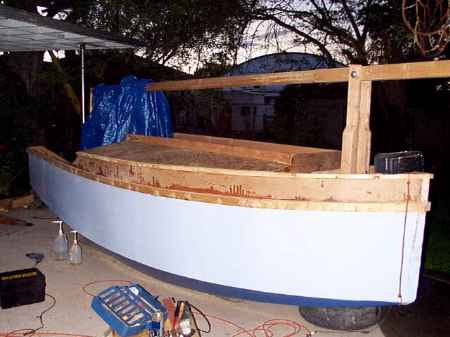
The down South Picara is more or less complete now. Should have an updated photo soon.
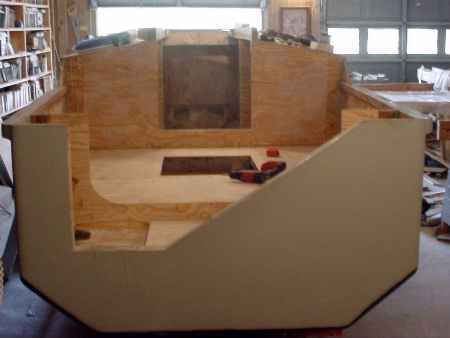
This long and lean project is a 19' version of Toon2. Shown here on its first sail in very light winds. We will wait a bit longer to get a sailing report in stronger winds.
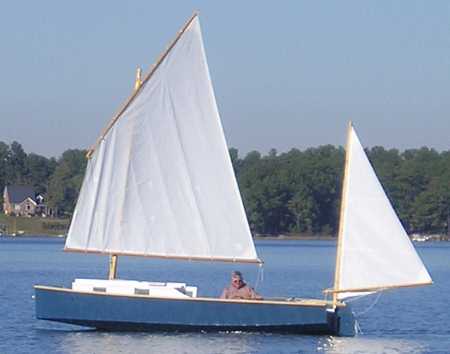
A Vector builder is keeping a website of the project at http://www.geocities.com/michsand@sbcglobal.net/ and here is a photo of his boat on its first sail, just before the storm hit. I also have photos of a Vector completed by Pete Mohylsky in Florida. Hopefully a report soon:
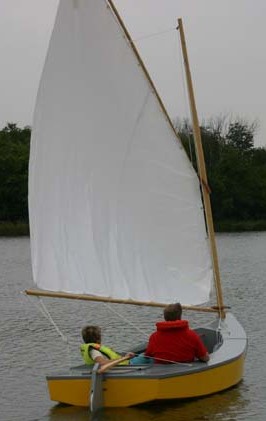
Here is a Musicbox2 I heard about through the grapevine.
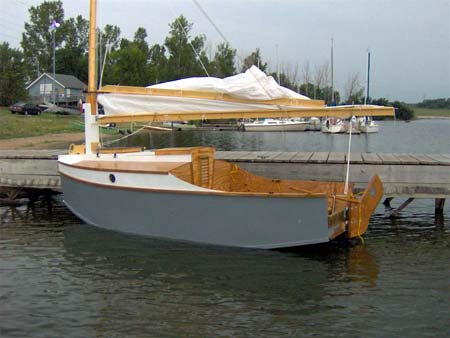
We have a Philsboat going together in California:
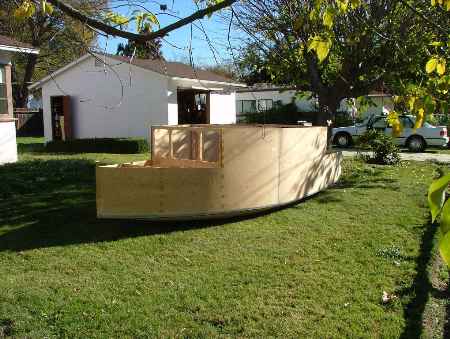
And here is another Philsboat in northern Illinois:
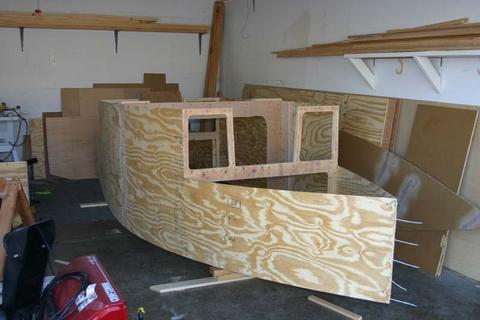
AN INDEX OF PAST ISSUES
Hullforms Download (archived copy)
Plyboats Demo Download (archived copy)
Brokeboats (archived copy)
Brian builds Roar2 (archived copy)
Herb builds AF3 (archived copy)
Herb builds RB42 (archived copy)